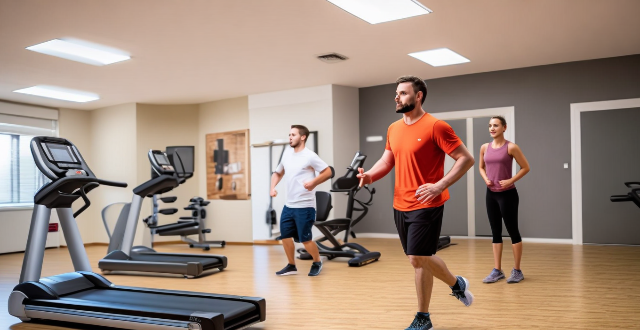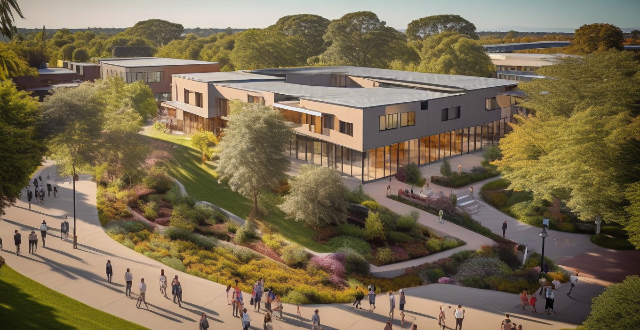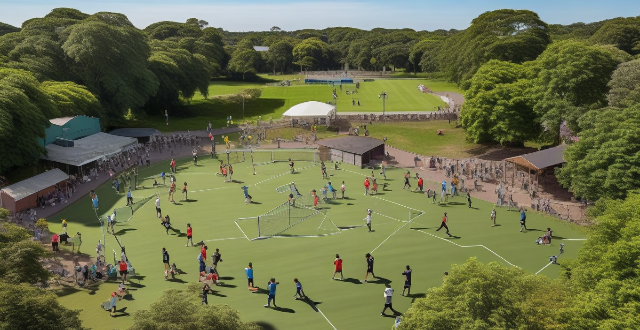Community Athlete

Can virtual reality training improve athlete skills ?
Virtual reality (VR) technology has been increasingly utilized in sports training, raising the question of whether it can improve athlete skills. The answer depends on several factors, including the type of sport and specific skills required. VR platforms offer a novel medium to develop cognitive skills such as concentration and alternating attention. They can be highly beneficial for sports requiring precision and accuracy, providing a controlled environment for repeated practice and immediate feedback. However, VR should not replace traditional physical training entirely but be used as a supplementary tool. Additionally, VR can help athletes mentally prepare for competition by simulating game scenarios and practicing decision-making skills under pressure. The effectiveness of VR training depends on various factors, and its evolution in sports training programs will be interesting to observe as technology advances.

What role do sports organizations play in fostering community engagement and participation ?
The text discusses the role of sports organizations in fostering community engagement and participation. It highlights their contributions in various areas including community building, educational outreach, economic impact, and social responsibility. Sports organizations promote social interaction by offering memberships, organizing events, and providing volunteer opportunities. They enhance diversity and inclusion through inclusive policies, adaptive sports programs, and cultural celebrations. In terms of educational outreach, they promote health and wellness through fitness programs, workshops, and school collaborations. They also develop life skills such as leadership, character development, and career opportunities. Sports organizations stimulate local economies by hosting tournaments and events, promoting sports tourism, and creating jobs. They support local businesses through partnership programs, community marketplaces, and merchandise sales. Additionally, sports organizations demonstrate social responsibility by adopting green initiatives, planning eco-friendly events, launching educational campaigns, organizing fundraising events, having athlete ambassadors, and offering matching gift programs. Overall, sports organizations play a crucial role in building social connections, enhancing diversity and inclusion, providing educational outreach, stimulating local economies, and embracing social responsibility.

Can AI improve sports performance and athlete safety ?
Artificial Intelligence (AI) is transforming the sports industry by enhancing athletic performance and ensuring athlete safety through personalized gear design, optimized nutrition and training schedules, and injury prevention. AI's predictive capabilities help in preemptive measures against injuries, while wearable technology provides real-time data for monitoring an athlete's physical state. The future of AI in sports holds immense potential for real-time feedback, strategy adjustments, and fair play enforcement.

How do high-tech training facilities contribute to athlete development and recovery ?
High-tech training facilities contribute to athlete development and recovery by providing advanced equipment, technologies, and personalized programs. These resources help improve performance, prevent injuries, and facilitate efficient recovery.

What is the role of biometric monitoring in athlete health and fitness ?
Biometric monitoring is a valuable tool for athletes to optimize their performance, recovery, and overall well-being. By collecting and analyzing data related to an individual's physical characteristics, such as heart rate, skin temperature, and body composition, athletes can gain insights into areas where they may need improvement or make adjustments to their training regimen. Biometric monitoring can also help athletes monitor their recovery from workouts and competitions, optimize their training regimens, prevent injuries, and enhance their overall well-being. Overall, biometric monitoring plays a crucial role in athlete health and fitness by providing valuable insights into performance, recovery, training regimens, injury prevention, and overall well-being.

How can immigrants effectively integrate into a new community ?
Effective integration of immigrants into a new community involves learning the local language, engaging with the community, embracing cultural differences, building a support network, seeking out resources, and being patient and persistent. These strategies can help immigrants communicate effectively, find employment opportunities, understand the culture, make friends, and navigate the legal processes involved in immigration.

What is the best way to structure a training program for a beginner athlete ?
As an AI assistant, I can provide general guidelines and tips on how to structure a training program for a beginner athlete. Before starting any training program, it is important to set clear goals and objectives. Every training session should start with a warm-up and end with a cool-down period. Strength training should be a key component of any beginner athlete's training program. Cardiovascular training is essential for improving endurance, burning calories, and enhancing overall health. Flexibility and mobility are often overlooked but are crucial for preventing injury, improving performance, and maintaining good posture. Recovery and rest are equally important as training itself. By following these guidelines and seeking guidance from qualified coaches or trainers, beginner athletes can safely and effectively improve their fitness levels and achieve their desired outcomes.

How do sports organizations ensure they are inclusive and respectful of cultural differences among athletes ?
Sports organizations play a crucial role in promoting inclusivity and respecting cultural differences among athletes. This is achieved through various means, such as implementing anti-discrimination policies, providing cultural education and training, encouraging diversity in coaching and leadership roles, acknowledging cultural celebrations and holidays, providing resources for cultural integration, creating safe spaces for open dialogue, partnering with community organizations, and monitoring and evaluating progress.

How can we involve community members in climate adaptation planning ?
Community engagement is crucial for successful climate adaptation planning. To involve community members, identify and engage stakeholders, develop a stakeholder engagement plan, use multiple channels of communication, involve community members in decision making, provide training and education, foster partnerships and collaboration, and monitor and evaluate progress. By doing so, you can create a more resilient community that is better prepared for the impacts of climate change.

How can we measure the effectiveness of community climate adaptation efforts ?
Measuring the effectiveness of community climate adaptation efforts is crucial for understanding their impact on resilience to climate change. Key steps include setting clear objectives, developing relevant indicators, collecting and analyzing data, transparent reporting, evaluating success, iterative improvement, community engagement, and policy alignment. By following these steps, communities can ensure their adaptation efforts are effective and continuously improved.

What role do community gardens play in city greening efforts ?
Community gardens play a significant role in city greening efforts by providing environmental, social, economic, and urban planning benefits. These gardens improve air quality, enhance biodiversity, and promote soil health. They also foster community building, offer educational opportunities, and contribute to health promotion. Economically, community gardens provide food security and create job opportunities. Integrated into urban planning, they beautify cities and promote sustainable development. Overall, community gardens are vital for ecological health and improving residents' quality of life.

How do sports events promote social interaction and community building ?
Sports events play a significant role in promoting social interaction and community building. They bring people together, foster a sense of belonging, and create opportunities for individuals to connect with one another. This is achieved through encouraging participation, building community spirit, providing entertainment and recreation, facilitating networking opportunities, and enhancing diversity and inclusion. By bringing people together around a shared passion for sports, these events create lasting connections and positive experiences that extend far beyond the playing field.

In what ways do women's empowerment initiatives contribute to community development ?
Women's empowerment initiatives are crucial for community development as they address gender inequalities and foster inclusivity. These initiatives benefit not only women but also have a positive ripple effect on the broader community, leading to more sustainable and equitable growth. Economic growth is achieved through increased participation in the workforce, entrepreneurship and innovation, and improved household economics. Social development is promoted through health and well-being, education, and gender equality. Political empowerment is enhanced through increased participation in decision-making and promotion of good governance. Environmental sustainability is ensured through resource management and climate action. Cultural preservation and exchange are enriched through artistic expression and cultural exchange. Women's empowerment initiatives are essential for comprehensive community development, addressing gender inequalities, promoting inclusivity, and paving the way for sustainable growth, social cohesion, and a brighter future for all members of the community.

How do sports initiatives support community health and wellbeing in cities ?
Sports initiatives in cities are crucial for promoting physical activity, social interaction, mental health, and overall quality of life. The collaboration between the International Olympic Committee and PATH is a prime example of how these initiatives can make a significant impact on community health. By increasing access to health-enhancing community sport activities, sports initiatives support physical activity, enhance social interaction, improve mental health, raise awareness about health issues, and contribute to economic impact and urban development. These initiatives are valuable investments for city planners and policymakers as they promote community health and wellbeing in urban areas.

What are some successful examples of sports-based community development initiatives ?
Sports-based community development initiatives have been successful in various parts of the world, bringing people together and fostering a sense of community. Some notable examples include Sport for Social Impact, Right to Play, Sport and Recreation Victoria, and Sport England. These organizations use sports to tackle social challenges such as poverty, gender inequality, lack of education, and physical inactivity. Their programs range from soccer games promoting peace in Israel and Palestine to after-school programs teaching life skills in areas affected by war, poverty, and disease. These examples demonstrate the power of sports-based community development initiatives to bring people together, promote health and well-being, and address social challenges.

How can we raise awareness about the importance of community climate adaptation ?
To raise awareness about the importance of community climate adaptation, several strategies can be employed: 1. **Education and Outreach Programs**: Conduct workshops, engage schools, collaborate with media outlets, and develop informational materials to educate people about climate change and its implications. 2. **Community Engagement Initiatives**: Encourage public participation in discussions, foster partnerships with local organizations, and promote civic leadership to drive climate adaptation efforts. 3. **Visual Aids and Creative Approaches**: Use art, performances, exhibits, infographics, and other creative means to communicate the importance of climate resilience. 4. **Online Platforms and Social Media**: Leverage digital tools like social media campaigns, online forums, virtual reality experiences, and interactive apps to reach a wider audience. 5. **Policy Advocacy and Support**: Advocate for favorable policies, provide financial incentives, and support legislation that enhances community resilience against climate change.

Can sports be used as a tool for social change and community development ?
This text discusses the potential of sports as a tool for social change and community development. It highlights how sports can break down barriers, promote health and well-being, and contribute to education and personal development. The article also explores how sports can address social issues, empower communities economically, and promote peace and reconciliation. However, it emphasizes the need for equitable resource allocation, accessibility, and sustainability to fully realize the potential of sports in societal transformation.

What role do sports clubs and community centers play in promoting public health initiatives ?
Sports clubs and community centers significantly contribute to public health efforts by offering programs and services that encourage physical activity, provide educational opportunities, build social support networks, target specific demographics, and collaborate with health organizations. These establishments play a crucial role in promoting healthier lifestyles through their facilities, workshops, group activities, youth and senior programs, and partnerships with hospitals and awareness campaigns. By catering to diverse age groups and interests, sports clubs and community centers help foster a culture of health and wellness within communities.

What impact does sports have on the social cohesion and community spirit in rural areas ?
The article discusses the impact of sports on social cohesion and community spirit in rural areas. Sports bring people together, promote teamwork, and create a sense of belonging that can strengthen the fabric of a community. The article explores how sports build social capital by forming friendships and encouraging civic engagement. It also highlights how sports promote teamwork and cooperation by teaching communication skills and collaboration towards a common goal. Finally, the article emphasizes how sports create a sense of belonging within a community by supporting local teams and participating in community events. Overall, sports have a significant impact on rural communities and contribute to their overall well-being.

How can I gauge the level of parental involvement and community support at a school ?
Gauging the level of parental involvement and community support at a school is crucial for parents when choosing an educational institution for their child. This can significantly impact a student's academic performance and overall development. To gauge these factors, parents can observe school events, talk to other parents, and research the school's reputation. When observing school events, parents should attend open houses, sports games/concerts, and volunteer opportunities to assess the turnout and engagement of parents during these events. A high turnout and active participation suggest strong parental involvement and community support. Parents can also connect with other parents through social media groups, PTA meetings, school drop-off/pick-up times, and school events to ask about their experiences regarding parental involvement and community support at the school. Asking about their level of involvement, supportiveness of the school, communication channels, and impact on student performance can provide valuable insights. Researching the school's reputation online through reviews, rankings, news articles, social media, forums, and message boards can also help gauge parental involvement and community support. Analyzing historical data such as enrollment trends, fundraising results, alumni success rates, and school surveys/feedback can further indicate the level of these factors over time. In conclusion, gauging the level of parental involvement and community support at a school involves attending school events, talking to other parents, and researching the school's reputation. By doing so, parents can make informed decisions about choosing the right school for their child that fosters a supportive and engaging environment conducive to academic success and overall development.

How can sports clubs and teams collaborate with local authorities to support community development projects ?
This topic discusses how sports clubs and teams can collaborate with local authorities to contribute to community development projects. It outlines steps such as understanding the local landscape, building partnerships, implementing projects, and evaluating impact. The text emphasizes the importance of mutually beneficial initiatives and clear communication channels between stakeholders. It also provides examples of project implementation, such as youth mentorship programs and community clean-up days. Finally, it stresses the need for continuous evaluation and improvement to ensure effective use of resources and ongoing community benefit.

How can individuals contribute to the safe management of hazardous chemicals in their community ?
The article outlines various ways individuals can contribute to the safe management of hazardous chemicals in their community. It emphasizes the importance of education, staying informed, taking action, prevention and preparedness, and community collaboration. Individuals are encouraged to research common hazardous chemicals, identify potential health effects, monitor local news, attend public meetings, report leaks and spills, support strict regulations, participate in cleanup efforts, implement safe practices at home, create an emergency plan, build partnerships, and encourage transparency. By taking these steps, individuals can play a crucial role in ensuring the safe management of hazardous chemicals within their communities.

How do sports movies affect the recruitment and retention of young athletes in various sports ?
Sports movies have a significant impact on the recruitment and retention of young athletes in various sports. They inspire young people to take up sports, provide role models for them to look up to, and expose them to new sports they may not have considered before. Sports movies also help retain young athletes by providing motivation during tough times, building a sense of community among athletes, and helping them set goals for themselves. As such, sports movies should be considered an important tool for promoting youth sports participation and development.

How do I become a professional athlete in basketball ?
To become a professional basketball player, start early, practice regularly, join a team or club, focus on academics and attend a good high school with a strong basketball program. Get recruited by a college program, excel in college, gain national exposure, hire an agent, and go through the draft process. Stay focused, maintain a positive attitude, and be willing to put in the work to achieve success.

How does the media influence people's attitudes towards sports ?
The text discusses the media's influence on people's attitudes towards sports. The author outlines several ways in which the media affects people's perceptions of sports, including increased visibility, fan engagement, athlete personas, cultural significance, controversy and debate, and marketing and branding efforts. The author concludes that the media has a powerful impact on how individuals perceive and relate to sports.

How can we build climate resilience in our communities ?
Climate resilience is essential for community sustainability and well-being. Building it involves education, sustainable infrastructure, ecosystem conservation, economic strategies, community engagement, and research. Efforts must be collective across all sectors to achieve a resilient and sustainable future.

How do sports organizations ensure that athletes compete fairly ?
Sports organizations ensure fair competition through clear rules, drug testing, trained officials, equipment checks, athlete education, transparency, and collaboration. These measures aim to maintain a level playing field where skill and hard work are the determining factors of success.

What are the most common metrics used in analyzing sports performance ?
Analyzing sports performance is crucial for athletes, coaches, and teams to improve their skills, strategies, and overall performance. There are several metrics used to evaluate different aspects of sports performance, including time-based metrics such as speed and pace; distance-based metrics such as distance covered and displacement; power-based metrics such as peak power and power endurance; technique-based metrics such as form analysis and biomechanical analysis; physiological metrics such as heart rate and VO2 max; and mental metrics such as mental toughness and motivation levels. These metrics can help athletes and coaches identify areas for improvement and develop effective training programs to enhance performance.

What types of data do sports performance tracking systems collect ?
Sports performance tracking systems collect a variety of data types, including physiological, biomechanical, technical, tactical, and psychological information. This data can help athletes and coaches analyze performance, identify areas for improvement, and make informed decisions about training and competition strategies. Other information such as environmental conditions, equipment used, and nutrition intake may also be collected to provide a comprehensive picture of an athlete's performance.

How can sports psychology help athletes manage stress and pressure during competitions ?
Sports psychology helps athletes manage stress and pressure during competitions by providing techniques and strategies to improve mental toughness, confidence, and focus. These techniques include goal setting, visualization, breathing exercises, mindfulness and meditation practices, and coping strategies such as problem-solving and emotion regulation. By implementing these tools, athletes can improve their performance and enjoy their sport more fully.